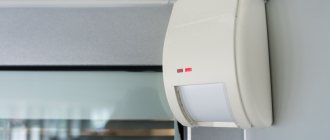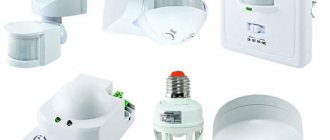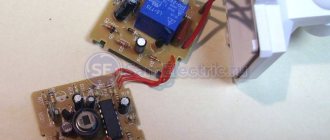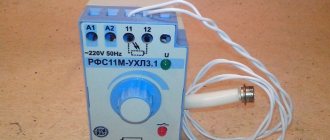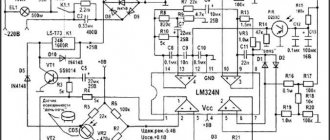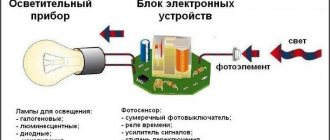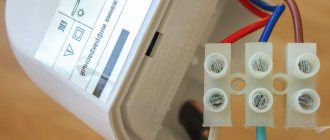Motion sensors for alarms, called infrared detectors, are the main element of the internal protection of a security alarm system. Infrared detectors operate on the principle of changing thermal radiation from the infrared range using a pyroelectric sensor, the electrical signal of which is analyzed by a special electronic circuit of the detector. This type of device does not emit its own energy and is battery-powered, ensuring that any change in infrared radiation in their field of view is accurately detected.
Infrared motion sensor
Let's look at the operating principle of an infrared motion sensor. Any object with its own temperature is a source of thermal radiation. The relationship between body temperature and the emitted wavelength of radiation is determined by Wien's law.
Infrared radiation is emitted by any body with a temperature below 500 degrees Celsius, but it is invisible to the eye. This is where an IR sensor comes to people's aid. When an infrared detector is analyzing an object, the mid-infrared and far-infrared ranges are most important. In addition, given that in most cases objects are in motion or in the air, the range of radiation is narrowed.
For IR sensors, the most important thing is the ability to respond to human movement, hence objects emitting infrared radiation with a wavelength of 10 mm. The radiation power of the human body is relatively small. The small difference in radiation levels caused by human movement in space becomes a relatively difficult task for the IR sensor. The solution to this problem is advanced optical systems that allow the detector's field of view to be properly shaped. Currently, Fresnel lenses are most often used in wireless alarms.
Another way to detect infrared radiation is to use mirror optics. Each entry or exit of an object from the field of view is detected by a sensor that records changes in the spectrum of infrared radiation. The change in the IR spectrum is then analyzed by a detector. If the change is large enough, an alarm is triggered.
It is also worth noting that a sudden change in temperature can cause a false alarm, but slow, gradual changes in temperature do not cause a response from the detector. To solve this problem, differential pyroelectric security alarm sensors are used, which increase resistance to changes in ambient temperature and thermal air movements. This is very important if you install a dacha alarm with a motion sensor and siren.
CONNECTION DIAGRAMS FOR SECURITY DETECTORS
Detector connection diagram ( Astra, Harp, Glass, Rustle, Photon
, in short, any) is always given in the passport of a specific alarm device, but contains only the purpose of the terminal block contacts.
It is worth noting that the example given here is maximum and is rare.
Almost always the block has one pair of monitoring station contacts and power connection contacts. Two pairs of monitoring station contacts are sometimes found on some combination detectors.
The additional contact “RES” is inherent in the “Astra 5” detectors, the TMP contacts are typical for the “Shoroh” detectors. The abbreviations used indicate:
- 12V GEN “+” - polarity and supply voltage
- Monitoring station - control panel pair (detector output informing about its status)
- REZ - additional contact for connecting the terminal element of the alarm loop (resistor). It is not connected in any way with the detector circuit, it just hangs in the air, that is, it is a technological
- TMP (TAMP) - tamper switch contacts - open when the detector housing is opened
A diagram for connecting several detectors to an alarm loop (that is, connecting them to each other) is usually not given, and this, despite its apparent simplicity and obviousness for beginners, can pose a serious problem.
Most security detectors have a monitoring station output (control pair), implemented on the basis of relay contacts. Moreover, in the “security” (“normal”) mode, the contacts are closed, and when the detector is turned off or switched to the “alarm” mode, they are open.
Therefore, the connection of a remote control pair of such detectors to the alarm loop is carried out sequentially, with the installation of the final element of the alarm loop, in most cases a resistor (R), after the last detector (IN).
Watch the video
How the alarm sensors actually connect to each other to form an alarm loop is shown in the following four figures.
This scheme for switching on detectors is very rare.
The only thing that can be useful from it is connecting tamper contacts (for example, for “Shorokh 2” detectors). True, often these contacts, even if they exist, are ignored, leaving them hanging in the air.
The following example of connecting security detectors is of practical importance and is used, for example, when organizing an alarm loop for the second line of security using Astra 5 detectors.
I want to say that the color scheme in the wiring diagrams of alarm sensors is used not only for beauty and ease of perception.
In practice, the connection of security detectors is carried out by a four-wire line, each of the wires of which has its own color, which greatly facilitates the installation of the alarm loop.
The third switching circuit is a special variant of the previous one and is used when the detector does not have the “RES” terminal. (The black circle indicates soldering of wires).
The options discussed above are good when using a hidden alarm cable.
In this case, the connecting line is led out of the wall or other building structure directly under the detector, which covers the output location, and all switching is carried out in the alarm device housing (the design of the room does not suffer).
The disadvantages of this method of installing detectors are the difficulty of maintenance (to find a fault, you need to open the device case), the relatively small free space inside the case, and the miniature size of the terminal block. Sometimes this method of installation becomes truly a piece of jewelry.
This is especially evident when installing detectors of the alarm loop of the first line of security.
The inclusion of magnetic contact detectors, which have flexible terminals, along with terminal detectors, makes switching inside the device body, as a rule, impossible.
You can, of course, use soldering, but then the question again arises of the convenience of troubleshooting during operation of the fire alarm system (sometimes errors made during installation).
The best option here is the use of switching devices, as demonstrated by the latest example of connecting security detectors, including magnetic contact detectors.
Once again, I draw your attention to the fact that alarm detectors that have closed contacts in the “norm” mode are included in the alarm loop sequentially.
There is a good way to check that the sensors are installed correctly in the alarm loop. Follow the connection chain in the direction of the arrow on the yellow wire to the exit on the green wire.
If you managed to pass through the contact pairs of ALL sensors, and only ONCE for each, then everything is in order. This is something like Euler's seven bridges problem.
© 2010-2022. All rights reserved. The materials presented on the site are for informational purposes only and cannot be used as guidance documents.
Pyroelectric detector in infrared sensors
The main component of the design of any autonomous infrared motion sensor is the so-called pyroelectric detector. Depending on the quality of the detector, it can have up to several detectors. Standard alarm detectors contain two light-sensitive devices. More advanced models of motion sensors with a siren are equipped with four light-sensitive devices, which are made of a special crystal that demonstrates a pyroelectric effect.
The pyroelectric effect is the phenomenon of the formation of electric charges on the surface of dielectric crystals under the influence of changes in their temperature. The pyroelectric effect occurs only in crystals that do not have a center of symmetry and with no more than one ordinary axis of symmetry.
A pyroelectric security motion sensor is a device that responds only to temperature changes. The spectral characteristics of the pyroelectric sensor are practically independent of the wavelength (range from ultraviolet to far infrared). For alarm systems, spatial visualization of temperature distribution is not essential. The only important factor is to identify changes occurring in this distribution.
The appearance of an intruder in the field of view of a wireless motion sensor causes a change in the initial temperature. This change could be caused, for example, by thermal detection of a fragment of an intruder's body against a wall that is characteristically at a much lower temperature. Unfortunately, such disturbances in temperature distribution can be caused by other factors such as drafts and sunlight.
Read more about the motion sensor, settings for higher accuracy, features of use in other systems.
Classification by device type
Depending on how information is obtained, volumetric devices are divided into active and passive.
Passive
Passive security alarm sensors, which are simpler in design, analyze data received only from the external environment. These devices record changes in the position of an object in space and can track the direction of its movement. A passive device does not use an additional source of energy; it receives it from objects of controlled volume and converts it into an output signal.
Active
Unlike a passive device, an active device requires energy from an external source. The presence of a generator and a receiving device in the design increases the chance of detecting a violation in the control zone, since forced radiation scans the entire protected space. If the excitation signal hits a moving object, then the reflected signal will have different parameters. This fact will cause an alarm.
Setting the aperture
To ensure high detection efficiency of Wi-Fi motion sensor, it is necessary to effectively eliminate all changes in temperature distribution caused by natural factors. As a rule, the elimination of these factors consists of dividing the field of view of the detector into several fragments. This means that the detector will respond to changes in the temperature distribution only in very small slices of the observed space.
Separation of the spheres of the field of view of a security alarm is most often carried out by installing a special diaphragm on the optical axis with slits that highlight a smaller field of view. Thanks to this solution, a moving intruder will appear sequentially in the monitored areas, which will lead to the detection of more infrared radiation and return the sensor to its original state at the moment the intruder is behind the diaphragm. The detector will operate in the same way as an AC voltage source, in which the corresponding electronic circuit will sequentially count the signal. When a certain count threshold is exceeded, the detector will sound an alarm.
Description and purpose
Security alarm systems used in premises can have either a specialized purpose or are based on the principle of multifaceted detection of unauthorized access. In the construction of such systems the following are used:
- Tamper sensors.
- Window break sensors.
- Volumetric sensors.
The first group is focused on installation in door and window structures and is designed to protect the perimeter of the room. The second provides protection only for window openings and is triggered when the integrity of the window glass is broken. Volumetric sensors make it possible to control the entire internal volume of a room, giving a signal when foreign objects or people are detected in the protected area.
Volume sensors, unlike reed switches and contact switches, have a wide range of operating functions and adjustment capabilities. When installed, they can be used not only as part of a security alarm, but also act as elements of a “smart home” system that turns on lighting, air humidity control, and fire alarms.
Filters
The biggest problem with infrared security motion sensors is detecting false alarms. To limit this phenomenon, special filters are used that cut off unnecessary visible radiation. These filters are most often germanium plates that are mounted in the housing of the pyroelectric sensor. Thanks to the use of filters, interference caused, for example, by turning lights on and off is eliminated.
Unfortunately, this solution is not without its drawbacks. The use of such a filter is associated with the absorption of up to 20% of IR radiation, which does not reach the pyroelectric sensor plate. In addition, you should also keep in mind that next to the pyroelectric effect, there is also a piezoelectric effect, which makes infrared detectors sensitive to shock and vibration.
Motion sensors with alarms work most effectively when a person crosses the detection zone at a right angle. In other words, an infrared detector provides effective detection when the object moves perpendicular to the optical axis of the detector. Also, thanks to the latest Fresnel lens, some detectors have several dozen observation beams. Any movement that occurs within the detector's observation zone is recorded - leading to an alarm.
Review of popular models
Echo -5
Security sensor used in both centralized security systems and local alarm systems. Ultrasonic device for detecting the movement of an intruder in a protected area.
Features and Specifications:
- System control of external effects of radiation overlap;
- Automatic performance check system;
- Adjusting the sensitivity level during setup;
- The maximum volume of the guaranteed control zone is 250 m2;
- Range - 10 meters;
- The speed of the object to trigger the device is 0.3-2 m/s;
- Degree of protection IP 30;
- Dimensions 150x45x25 mm;
- Weight – 75 g;
Argus -3
Radio wave volumetric detector. Designed for operation in heated and unheated premises as part of centralized and local security systems. It is distinguished by high reliability and reliability of detecting violations of the protected area. Use with similar devices in the same room is allowed.
Features and Specifications:
- Minimum range – 2-3 m;
- Operating temperature - -30 +50 degrees Celsius;
- Guaranteed detection area – 20 m2;
- Weight – 100 gr.
PYRONIX COLT QUAD P1
Passive infrared sensor. Used for installation in centralized and local security systems. The peculiarity of the design is the possibility of use in enclosed spaces with forced ventilation. Masking is allowed with materials that do not interfere with the propagation of radio waves - fabric, wooden gratings. The device has a high degree of protection against natural and artificial interference. Does not react to animals weighing up to 27 kg.
Features and characteristics of the device:
- The intruder detection zone is 10 m with a horizontal viewing angle of 90 degrees;
- Housing type – sealed;
- The case is protected from static voltage;
- Ambient temperature from -30 to +70 degrees Celsius;
- Dimensions – 75x52x44;
Optical systems of infrared detectors
Infrared detectors for home and garden are equipped with special optical systems, the task of which is to concentrate infrared radiation on the pyroelectric sensor. There are two main optical systems: based on mirror technology or Fresnel lenses.
Analyzing both systems from the point of view of their ability to detect an intruder, we can conclude that they are equal, and each of them has certain advantages and disadvantages. Manufacturers are striving to create optical systems whose design would allow an image to be produced on a plate in the form of a dot. Of course, in practice it is impossible to create an optical system with such a property. Today, a sufficient solution is to reduce the volumetric radiation beam to the size of the detector plate.
Most often you will encounter infrared detectors built on the basis of wide-angle lenses, which allow you to obtain a field of view from 90 to 130 degrees. The range of such detectors ranges from 12 to 15 meters.
Criterias of choice
Weather resistance
According to safety requirements, the housing must provide protection of electronic components from dust and solid particles of at least level 4 protection. Protection against moisture penetration is calculated at less than level 6.
For home use, it is enough to have devices that meet the IP44 and IP54 protection levels, which provides protection from dust and splashing water.
Reaction to external factors
Active detectors must be protected from electromagnetic radiation; for passive detectors, the reliability criterion is the protection factor relative to the reaction to pets.
Purpose
All types of devices are applicable for internal production and warehouse premises; for premises in which personnel may be present, the exception is ultrasonic sensors.
Appearance
Devices are selected for open or hidden installation. Open placement should provide an aesthetic appearance, and with hidden installation, compact housing and cable lines.
Infrared detectors type QUAD
It is also worth mentioning infrared detectors of the QUAD type. The task of any wireless motion sensor is to detect only the movement of an intruder, without reacting to side effects. In practice, it turns out that this is not at all so simple, because a person, an animal, a draft in a room, and the setting sun cause very similar pyroelectric phenomena. Therefore, it became an important task to create a device that is capable of distinguishing alarming events from false alarms caused by one of the above-mentioned factors.
One way to reduce the sensitivity of detectors to false alarms was to create a sensor that used two pyroelectric detectors located horizontally side by side. A sensor designed in this way has twice as many detection zones as a sensor with a single pyroelectric device. Elimination of false alarms consists of logical summation of the signal from both detectors. They are connected in such a way that the change in their polarization as a result of detecting radiation is always opposite to the other.
Of course, this solution is not ideal. Thanks to the development of technology, another solution is increasingly being used. If you could use two pyroelectric devices in one Wi-Fi motion sensor, then why not use more. As a result of this thinking, the innovative QUAD technology was developed, which allowed the use of up to four pyroelectric detectors.
Types by detection area
Often, alarm systems inside a building use different types of devices that differ in the characteristics of the controlled areas. Small rooms often require control of the entire volume of the room. Long-range sensors are installed in corridors, and to monitor large rooms it is often sufficient to install equipment near the main exits. These features formed the basis for the classification of sensors by object detection zone:
- Volumetric;
- Corridor;
- Curtains.
Volumetric
Devices whose main purpose is to control the entire volume of a room is a large angle of the sensor’s working area. The movement of a person or animal is recorded by the device in both horizontal and vertical projections, with a viewing angle ranging from 240 to 360 degrees. Most devices are capable of detecting movement in the frontal plane and perpendicular. The best option for installing such equipment is the ceiling option.
Bellhops
Corridor sensors, unlike volumetric sensors, have narrowly targeted coverage areas. The optimal parameters for these sensors are the following indicators:
- Horizontal angle 15-45 degrees;
- Vertical viewing angle up to 60 degrees.
Such characteristics allow for high efficiency in long corridors or aisles along their entire length.
Curtains
Models of “curtain” type devices allow for control over a separate section of the perimeter. The sensors have a narrow sensing band. This allows you to reliably record all crossings of the conventional security line even by the smallest objects.
How the technology works
Infrared remote detectors using QUAD technology have four pyroelectric detectors. They are located differently. As standard, they are installed next to each other, which allows four detection zones using one Fresnel lens or one mirror. However, a much more commonly used arrangement for pyroelectric devices today is to arrange them in two rows of two detectors.
Thanks to this arrangement, the detection zones are grouped into groups of four beams. Looking at the diagram above, it can be concluded that QUAD detectors have two detectors with dual pyroelectric sensors. In infrared detectors with QUAD technology, the electrical signal from each pair of pyroelectrics is processed separately in an analog-to-digital chip.
Advantages and disadvantages
When considering shock sensors, the following advantages are highlighted:
- Reliable territory protection.
- Possibility to turn on the light when the object is in place.
- Accurate identification of people.
- Wide range of products.
However, the models are useless in areas where pets run around. The detection range is usually short, and the devices do not always work. There is no possibility of fine adjustment of sensitivity; a large number of false signals are observed.
Installation of motion sensors
To ensure the correct operation of motion sensors for the protection of premises, it is necessary to be guided by several basic (but extremely important) principles:
- Due to convection, the infrared detector should not be installed directly above the heat source;
- the outdoor motion sensor should not be located in a place where it is exposed to direct sunlight;
- do not use IR detectors to protect windows (air movement in the window area can lead to a false alarm);
- all moving objects must be at least 3 meters away from the wireless motion sensor;
- none of the detection sectors of the infrared detector should cover areas where significant changes in temperature distribution occur;
- the detector must be installed stably, since vibration and shock negatively affect its operation and cause false alarms;
- If, when installing a detector, one of the above requirements is not met, use infrared detectors of a higher class.
Of course, the most important connection rule is the correct choice of installation location. When installing an infrared detector, first of all you should avoid places where the operation of the pyroelectric sensor may be disrupted by one of the following factors:
- solar radiation incident on the detector;
- rapid or severe temperature changes;
- strong air movement;
- sounds too loud;
- strong electromagnetic radiation;
- radio interference;
- electrical discharges;
- vibration;
- accumulation of animals, for example, in the country;
- direct interaction of water or oil vapors.
It's also worth remembering the still little-known effect of wireless motion sensors. Installing an infrared detector in an apartment whose dimensions are significantly smaller than the nominal range of the sensor can lead to obvious disruptions in its functioning. One of the negative consequences of this situation is the frequent occurrence of false positives. Given this fact, keep in mind that you should not use motion sensor alarms in rooms smaller than 30-50% of the standard detector range.
Installation and connection features
For each device, the manufacturer must indicate in the operating instructions the critical points for installing and connecting the device.
The following installation options are standard for internal sensors:
- ceiling option;
- dome installation option;
- installation in the corner of the room;
When choosing an installation location, the following are taken into account:
- technical characteristics of the sensor;
- frontal and horizontal angles of the sensor working area;
- linear dimensions of the room, placement of door and window openings;
- factors affecting the operation of the device - elevation angle above the surface, dust and gas contamination of the room, temperature conditions;
- specifics of the security object - open or hidden installation of devices;
- protection of the installation point from third-party influences.
In addition, during installation it is necessary to calculate the route of laying cable lines, the installation location of the wireless communication module and the power source for the sensor.
Where to buy sensors
You can purchase motion sensors either in a specialized store or online in an online store. In the second case, the budget option for purchasing products on the Aliexpress website deserves special attention. For some lamps there is an option for shipment from a warehouse in the Russian Federation; they can be received as quickly as possible; to do this, when ordering, select “Delivery from the Russian Federation”
| Infrared motion sensor | KERUI motion sensor | Aqara motion sensor for Xiaomi |
| Motion detector for home alarm | Motion sensor SONOFF SNZB-03 | Microwave Radar Motion Sensor |
Features of the perimeter system
The perimeter system is based on the concept of perimeter - this is a closed figure. Sensors must completely cover the territory. Their performance is influenced by the following factors:
- Weather precipitation.
- Presence of fog.
- Movement of trees.
- Flight of birds.
- Presence of animals.
Security companies, taking into account all the above factors, do not connect the system to the central console, however, the device is the first barrier for intruders.
